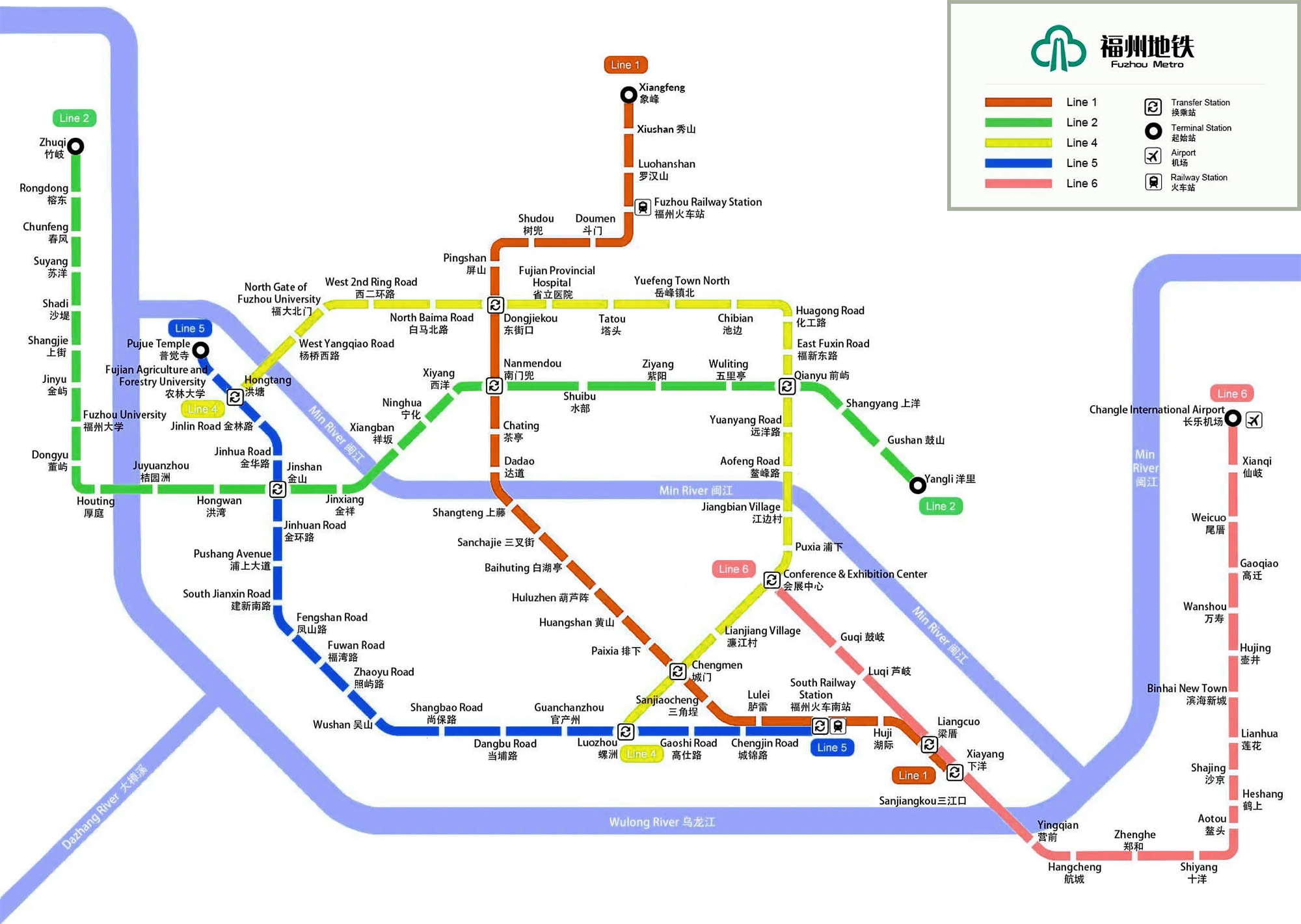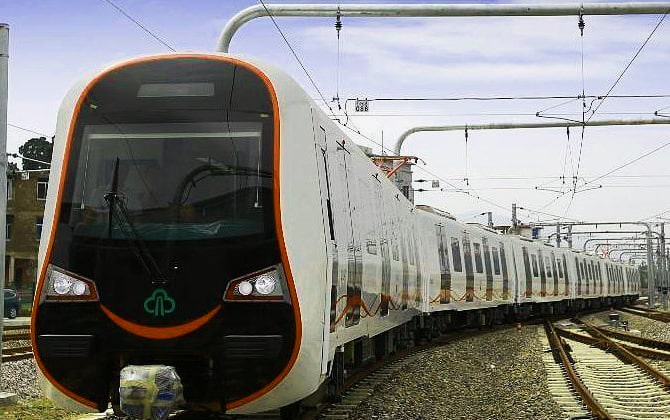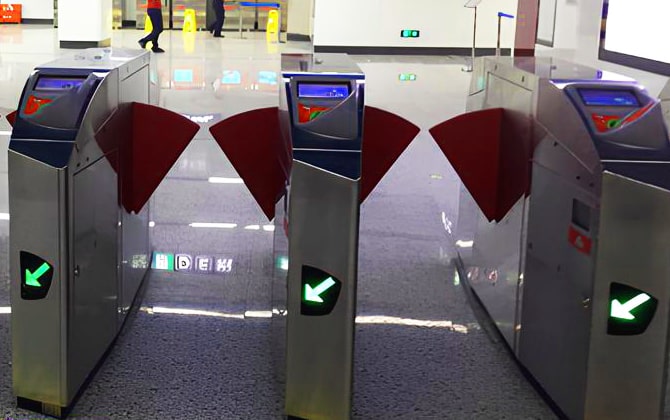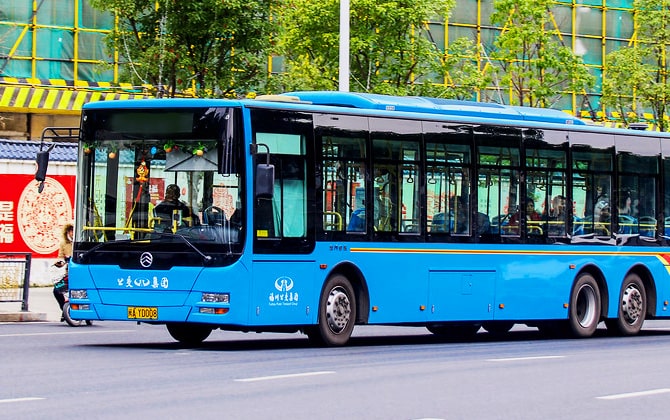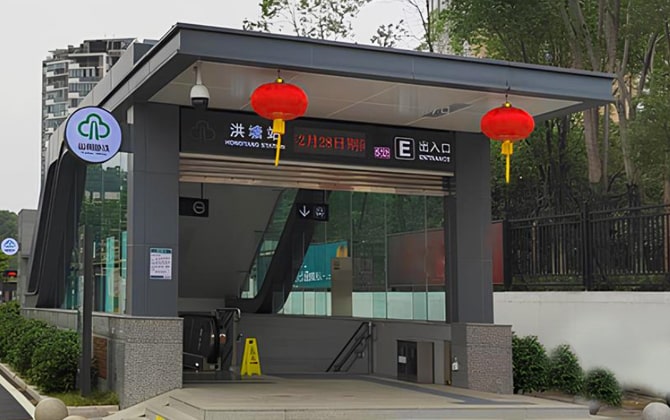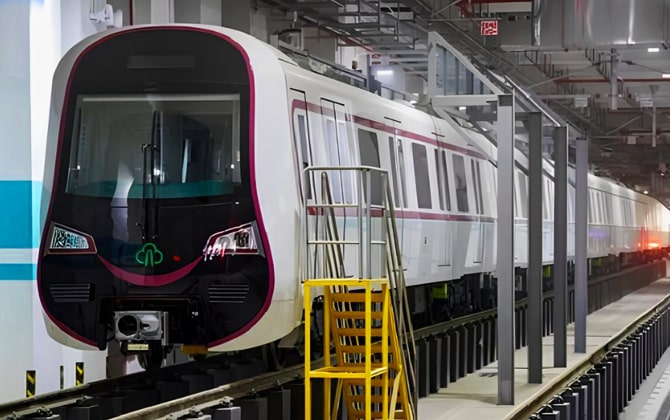Fuzhou Metro is the rapid transit system serving Fuzhou, the capital of Fujian Province, China. It opened its first line on May 18, 2016. As of 2026, five lines operate: Lines 1, 2, 4, 5 and 6. Together, they cover about 143.5 km (89 mi) of track and serve 119 stations. The trains are fast, air-conditioned, and span the city’s urban districts. On average, the network carries 700,000 passengers daily. It links major rail stations and bus hubs, helping tourists and locals avoid traffic.
Fuzhou Metro Map (2026)
The 2026 Fuzhou metro map shows all five lines and their stations. It spans central Fuzhou and reaches into the suburbs. Key interchanges are clearly marked: Fuzhou Railway Station on Line 1 and South Railway Station on Lines 1 and 5. Station names appear in English and Chinese, and each line uses a distinct color. With this map, first-time visitors can plan trips, spot lines serving popular areas, and find transfer points. Keep a digital or printed copy handy when exploring the city by subway.
Click on the map to enlarge it or download the Fuzhou subway map in PDF format.
Fuzhou Metro Lines and Stations
Line 1: Runs from Xiangfeng in the north to Sanjiangkou in the south. This first line opened in 2016. It passes through Jin’an, Gulou, Taijiang and Cangshan districts. The route is 29.5 km (18 mi) long and has 25 stations. Major stops include Fuzhou Railway Station and Fuzhou South Railway Station. Traveling end to end takes about 55 minutes.
Line 2: Stretches 30 km (18.6 mi) east–west from Suyang (Minhou County) to Yangli (Jin’an District). It opened in 2019 and has 22 stations. The line serves Fuzhou University and Fujian Normal University. It meets Line 1 at Nanmendou. A separate company runs the line, but tickets and transfers work seamlessly across the network.
Line 4: Runs 24 km (14.9 mi) from Fenghuangchi (Gulou District) to Difengjiang (Cangshan District). Opened in 2023, it has 19 stations. It crosses the Wujiang River. Key stops include Dongjiekou (transfer to Line 1) and Provincial Hospital. This is Fuzhou’s first fully driverless metro line.
Line 5: Connects Jingxi Houyu (Minhou) in the northwest to Fuzhou South Railway Station. Completed in 2023, it covers 27.7 km (17.2 mi) with 20 stations. It serves Fujian Agriculture and Forestry University, the Jinshan industrial zone and Ancient Luozhou Town. Transfers are available at Difengjiang (Line 4) and South Railway Station (Line 1).
Line 6: Runs 31.4 km (19.5 mi) from Pandun (Cangshan District) to Wanshou (Changle District). Opened in 2022, 14 of its 16 stations are in service. The line is partly above ground and will connect to the airport in the future. Stations include Hangcheng and Zhenghe near Fuzhou New Area. Its operating hours are slightly shorter than other lines.
All stations display Chinese and Pinyin signs. Announcements play in Mandarin, Fuzhou dialect and English. Fuzhou Metro Stations are modern, clean and wheelchair-accessible. Platforms feature clear route maps and elevators.
Fuzhou Metro Schedule & Timetable
Operating Hours Today
The metro runs daily from early morning until late evening. Lines 1, 2, 4 and 5 start at 6:30 AM and end around 11:00 PM. Line 6 runs from 7:00 AM to about 10:30 PM. These times apply on weekdays and weekends. During holidays or special events, last trains may run later. Always check station notices or the official app for updates.
Opening and Closing Times
Line 1: First train departs at 06:30 from Xiangfeng and Sanjiangkou. Last train leaves at 23:00. The final service arrives at the far end around 23:50.
Line 2: First train at 06:30 from Suyang and Yangli. Last train at 23:00.
Line 4: First train at 06:30 from Fenghuangchi and Difengjiang. Last train at 23:00.
Line 5: First train at 06:30 from Jingxi Houyu and South Railway Station. Last train at 23:00.
Line 6: First train at 07:00 from Pandun and Wanshou. Last train at 22:30. Service used to end at 22:00 before extension in 2024.
Exact times may vary by a few minutes at each stop. Stations close entry 5–10 minutes before the last train. To catch the final service, arrive at least 10 minutes early for security and ticketing.
Frequency & Train Schedule
During peak hours (7:00–9:00 AM and 5:00–7:00 PM), trains on major lines run every 4–6 minutes. Line 1 can drop to 4.5-minute intervals. Lines 4 and 5 run every 5–6 minutes after a 2024 upgrade.
Off-peak trains arrive every 6–8 minutes. For example, Line 1 sees about a 6 min 50 sec gap midday. Even late at night, trains come every 8–10 minutes, keeping wait times under 10 minutes.
Platform screens display the next train’s arrival. Audio announcements also alert you to incoming trains. The system is punctual, and official Fuzhou Metro timetables are available on the metro website and station boards. If a train is full, the next one will arrive soon. Frequent service makes the metro a reliable way to travel across Fuzhou.
Fuzhou Metro Ticket Prices & Fares
Fare Calculator
Fuzhou Metro uses a distance-based fare system. Your ticket price depends on how far you travel:
- ¥2 CNY ($0.30 USD) for the first 5 km (3 mi).
- 5–15 km (3–9.3 mi): +¥1 CNY ($0.15 USD) per 5 km.
- 15–29 km (9.3–18 mi): +¥1 CNY ($0.15 USD) per 7 km.
- >29 km (18 mi): +¥1 CNY ($0.15 USD) per 9 km, capping around ¥7 CNY ($1.05 USD) for 30–35 km (18.6–21.7 mi).
The minimum fare is ¥2 ($0.30 USD). Most cross-city rides cost ¥6–7 ($0.90–$1.05 USD). Downtown trips usually cost ¥2–4 ($0.30–$0.60 USD). Fuzhou Metro Ticket machines calculate the fare automatically when you select your destination and accept ¥1 coins or ¥5/¥10/¥20 banknotes.
Ticket Types and Day Pass
Single-Journey Ticket (Token): A one-time-use plastic token. Tap at entry and insert at exit. Tokens are color-coded and marked “Metro Fuzhou.”
Rechargeable Smart Card (Rongcheng Metro Card): Buy at station service counters for a refundable ¥20 deposit ($3 USD). Tap to enter and exit. You get a 10% fare discount and can use it on buses and taxis. Top up at machines or counters.
Mobile Payment & QR Tickets: Scan a QR code in the “e-Fuzhou” or “Mashangxing” apps at the gates. Alipay and UnionPay QR codes also work. Foreign Visa/MasterCard support is available at staffed counters.
Day Pass / Multi-Day Pass: No unlimited day pass exists. All rides are pay-per-trip. Use the Rongcheng card for convenience and savings. You can refund the remaining balance and deposit at any major station.
How Much Does Fuzhou Metro Cost?
A typical city-center ride costs ¥2–3 CNY ($0.30–$0.45 USD). A longer trip rarely exceeds ¥6–7 CNY ($0.90–$1 USD). For example, Line 1 end-to-end (nearly 30 km/18.6 mi) costs ¥7 ($1.05 USD). Taxi fares for similar distances can exceed ¥30 ($4.50 USD) in traffic.
Many tourist spots lie within a few stops of each other. A suburb-to-core ride (~12 km/7.5 mi) costs around ¥4 ($0.60 USD). Budget ¥8–15 CNY ($1.20–$2.25 USD) per day for multiple rides. Use the Rongcheng card to shave 10% off each fare.
Routes and Connections
Connections with Fuzhou Bus and Airport
Most metro stations link directly to city bus stops. At Nanmendou (Lines 1 & 2), you can transfer buses without leaving the station area. Use the Rongcheng card for both bus and metro. Transfers within 90 minutes earn ¥1 CNY ($0.15 USD) off the metro fare or ¥0.5 CNY ($0.08 USD) off the bus fare.
Fuzhou Changle International Airport (FOC) lies about 50 km (31 mi) from the city. The Airport Express Line (Binhai Express, Line F1) will open by late 2026. Until then, airport shuttle buses run every 30–60 minutes for ¥20 CNY ($3 USD). Taxis cost ¥120–150 CNY ($18–$23 USD). You can also take Line 6 to Wanshou (its eastern terminus) and taxi the remaining 10 km (6.2 mi).
The metro serves Fuzhou Railway Station (Line 1) and Fuzhou South Railway Station (Lines 1 & 5). Pingshan Station (Line 1) is near North Coach Station. Gushan Station (Line 2) connects to regional bus hubs. Look for bus interchange info on exit signboards.
Fuzhou Public Transport Overview
Fuzhou’s public transport includes metro, buses, taxis and ferries. The metro is fast and avoids traffic. Buses reach every neighborhood with hundreds of routes. Taxis start at ¥10 CNY ($1.50 USD) for the first 3 km (1.9 mi). Ferries link riverfront spots. All modes accept the Rongcheng card and QR payments (Alipay/WeChat). Transfer between bus and metro within 90 minutes earns ¥1 CNY ($0.15 USD) off.
- Metro: Fast, reliable, English signage.
- Buses: Wide coverage, ¥1–2 CNY ($0.15–$0.30 USD) fares.
- Taxis/Ride-hailing: Apps like DiDi work. Good for late-night or door-to-door.
Facilities & Services
Parking Charges per Day
Many stations offer park-and-ride lots. Fees usually start at ¥5 CNY ($0.75 USD) for the first 2 hours. After that, a small hourly rate applies. Most lots cap at ¥20–¥30 CNY ($3–$4.50 USD) per 24 hours. At Fuzhou South Railway Station, the cap is about ¥50 CNY ($7.50 USD). Some suburban stations offer 30 minutes free or EV discounts. Look for “P” signs. Payments accept Rongcheng card or mobile pay. Lots are secure and close to entrances.
Fuzhou Metro Card – How to Use
Get a Rongcheng Metro Card at any station service counter. Pay a ¥20 CNY ($3 USD) deposit and load credit. Top up at machines, counters or via the app. To ride, tap in at entry and tap out at exit. The card gives a 10% metro discount and works on buses, some taxis and bikes. Check your balance at gates. To refund, return it at a service counter for your deposit and remaining balance (small fee may apply). The card stays valid for years.
Rules & Useful Tips for Riding
Is Fuzhou Metro Safe? Safety Tips
- All riders pass X-ray and metal detectors at entry.
- Stay behind the yellow line until doors open.
- Let passengers exit before boarding.
- Hold rails; trains can start or stop quickly.
- No eating, drinking or smoking on trains.
- Use emergency intercoms or find staff if you need help.
Stations have CCTV and screen doors. Staff and security guards patrol platforms. Announcements play in Mandarin, Fuzhou dialect and English.
Guide for First-Time Users
- Enter: Find a red “福州地铁” entrance. Note exit number. Clear security checks quickly.
- Buy Ticket: Use vending machines with English option. Tap your destination. Insert ¥1 coins or ¥5–¥20 bills. Or go to the counter.
- Tap In: Use the token sensor or tap your card at the gate. Follow signs to platforms by line number and direction.
- Board: Wait for passengers to exit. Move to the center of the car.
- Ride: Watch LED maps and listen to announcements. Hold rails if standing.
- Exit: Tap out or insert token at gates. Follow exit signs and numbers to street level.
Stations offer toilets, vending machines and Wi-Fi hotspots. For help, ask staff or check English signage. Plan your last train to avoid getting stranded. Taxis are a backup option after hours.
Interesting Facts & History
- Long Planning, Fast Growth: The metro was approved in 2009 but delayed by soft soil and archaeological finds. Line 1 finally opened on May 18, 2016. By 2023, five lines were in service.
- First Day and Ridership: Line 1’s launch included a free trial. Today, the network carries around 700,000 riders daily. Special events—like the 2026 Digital China Summit—have even offered free week-long rides.
- Dual Operators: Line 2 is run by Fuzhou CETC Rail Transit Co., Ltd., while the other lines belong to Fuzhou Metro Group. Despite separate operators, tickets and fares are fully unified.
- Nuclear Shelter Design: Underground stations and tunnels double as civil defense shelters with reinforced, “nuclear-resistant” structures.
- Line 4 “Smart Metro”: Opened in 2023, Line 4 is fully automated (GoA4) using Siemens signaling—the first driverless metro in Fujian Province.
- River Crossings: Lines 2 and 4 tunnel under the Min River and Wu River. Engineers used custom boring machines to handle waterlogged, granite terrain.
- Cultural Discoveries: Song Dynasty relics surfaced near Dongjiekou Station. Archaeologists preserved or relocated artifacts before construction resumed.
- Sustainability: Stations feature LED lighting, water-saving fixtures and solar panels. Trains use regenerative braking to feed energy back into the system.
- Name Origins: Many station names reflect local landmarks (e.g. Sanchajie means “Three Forks Street”).
- City Nickname & Logo: Fuzhou is called “Banyan City” (Rongcheng). The metro logo combines an “F” and wave to evoke banyan roots spreading through the city.
Future Expansions & Upcoming Lines
- Binhai Express (Line F1): Opens in late 2026. It will link Fuzhou Railway Station to the airport over 61.5 km (38.2 mi), with trains running up to 140 km/h (87 mph) and a 30-minute journey time.
- Line 4 Extension: A 3.7 km (2.3 mi) segment to Banzhou with four new stations arrives in 2026, completing Line 4’s 28.4 km (17.7 mi) planned loop.
- Line 2 Eastern Extension: By 2026, a 16.9 km (10.5 mi) stretch to Mawei Port with 10 stations will open, bringing service to historic shipyards and maritime museums.
- Line 6 Extension: Also due in 2026, Line 6 will extend east from Wanshou to Shibakongzha with five new stations, edging closer to the coast.
- Line 3 (Under Construction): A ~30 km (18.6 mi) route with about 25 stations, linking Nantai Island to Nanyu Town. It is expected to open around 2026–2027.
- Lines 7–9: Planned for the 2030s. Line 7 will serve coastal suburbs; Line 8 will run ~50 km (31 mi) north–south between University Town, Software Park and Changle; Line 9 will cover ~24 km (15 mi) through Changle New Town.
- Intercity Line S1: Proposed to link Fuzhou with Fuqing and neighboring cities, forming a regional rapid-transit network.
